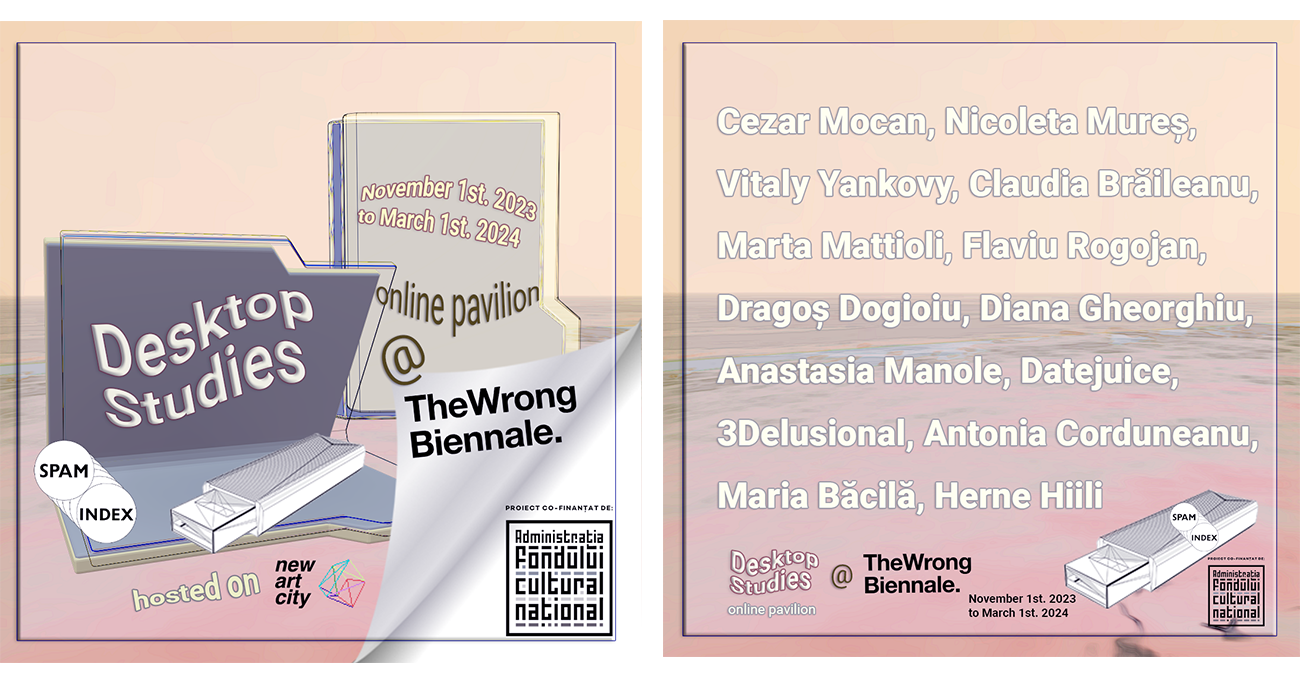[Close]
Desktop Studies pavilion @ The Wrong Biennale
The evolution of desktops from large, stationary machines into sleek, portable devices like tablets and phones has eased our access into the digital realm. As we spend more time in virtual worlds, it is crucial to be aware of their potential to isolate, distract, or distort our experiences. While screens and digital tools offer immense possibilities for connectivity and knowledge, we must also confront the limitations and biases embedded in the technology we interact with. The idea of these devices as portals becomes central to understanding the delicate balance between their benefits and potential pitfalls.
For the 6th edition of The Wrong Biennale, spam-index chose the newart.city platform to host its online pavilion, Desktop Studies. Designed to mimic USB sticks with nested folders, the exhibition is divided into two main sections, guiding the audience through an experience where the 14 featured artists present works that transition from a corporate focus – in the first scene – to a more personal exploration – in the second.
Cezar Mocan initiates our journey with a two-channel video that challenges the desktop metaphor’s legacy, a concept famously propagated by Apple through its 1987 Macintosh Human Interface Guidelines. Nicoleta Mureș takes a satirical approach, depicting the modern worker as a cockroach-human hybrid in her dynamic 3D scene, vividly illustrating the relentless corporate machinery and the pursuit of distraction prevalent in our productivity-driven culture.
Shifting towards aesthetics, Vitaly Yankovy‘s video examines the fusion of security and art in corporate spaces, underlying the aesthetics of protection within modernist buildings. On the other hand, Claudia Brăileanu reveals how digital technologies influence our perception of the natural landscape, emphasizing the importance of the medium in shaping artistic experiences, while Marta Mattioli‘s works embody organic forms juxtaposed with metallic materials, pointing to the intertwine relationship between nature and technology and disputing traditional divisions.
In a different context, Flaviu Rogojan‘s project blurs boundaries, combining scientific facts and speculative fiction to reimagine the rebirth of the lost NASA’s ‘Deep Impact’ space probe.
In the second part of the pavilion, Dragoș Dogioiu looks into the multidimensional latent space of artificial intelligence to re-contextualize historical events, showing the algorithmic perspective on information flow. In a world where technology reframes the past, Diana Gheorghiu scrutinizes the misuse of social media to propagate misinformation and ideologies through magical thinking, raising concerns about the role of online influencers as modern clergy. On the same critical note, Anastasia Manole questions how AI defines our beliefs about femininity and beauty standards, shedding light on the complex relationship between technology and societal perceptions.
Tapping into the realm of oneiric, the works of Datejuice and 3Delusional deal with the surreal and intimate facets of the digital existence. In Datejuice‘s piece, the lucid dream symbolizes a personal addiction to digital content and its consequences on the artist’s well-being. In contrast, 3Delusional‘s video paints a picture of the Internet as a repository for individual experiences and memories that transcend the boundaries of time and reality, adding to the collective narrative of humanity.
Antonia Corduneanu and Maria Băcilă touch upon spiritual themes in the midst of a changing world. While Corduneanu‘s sculpture captures a pivotal moment in Christian mythology, urging self-reflection as humanity grapples with its decisions in the pursuit of knowledge, Băcilă uses her website to illustrate the rise of new spiritual beliefs and how the Internet becomes a source for mystical exploration, particularly amid the erosion of traditional institutions and the challenges posed by the pandemic.
Marking the end of the group show, Herne Hiili’s project with similar name invokes nostalgia and introspection, revealing fragments of the artist’s digital archived memories throughout an interactive 4 leveled website.
Collectively, the works showcased within the Desktop Studies pavilion encourage deeper contemplation about the impacts of corporate culture, the merging of reality and the virtual, the significance of technology in spirituality, art, personal lives, and in the quest for knowledge, the influence of digital media, the inescapable algorithms and the fading boundaries between humanity and machines. These explorations remind us to reconcile the benefits of connectivity with the protection of our privacy and to ensure technology does not perpetuate systems of exploitation and control.
✧・゚:*[Artist Index]*:・゚✧
|Cezar Mocan| -o- |Nicoleta Mureș| -o- |Vitaly Yankovy| -o- |Claudia Brăileanu| -o- |Marta Mattioli| -o- |Flaviu Rogojan| -o- |Dragoș Dogioiu| -o- |Diana Gheorghiu| -o- |Anastasia Manole| -o- |Datejuice|-o- |3Delusional| -o- |Antonia Corduneanu|-o- |Maria Băcilă| -o- |Herne Hiili|
*Use the arrows or WASD (to go front/back/left/right) and simultaneous the mouse (for a higher or lower POV)
**To see all the artworks, please enter or click the portals you encounter.
***There are 6 different scenes. To switch between them press ESC
****Better experience on PC/laptop
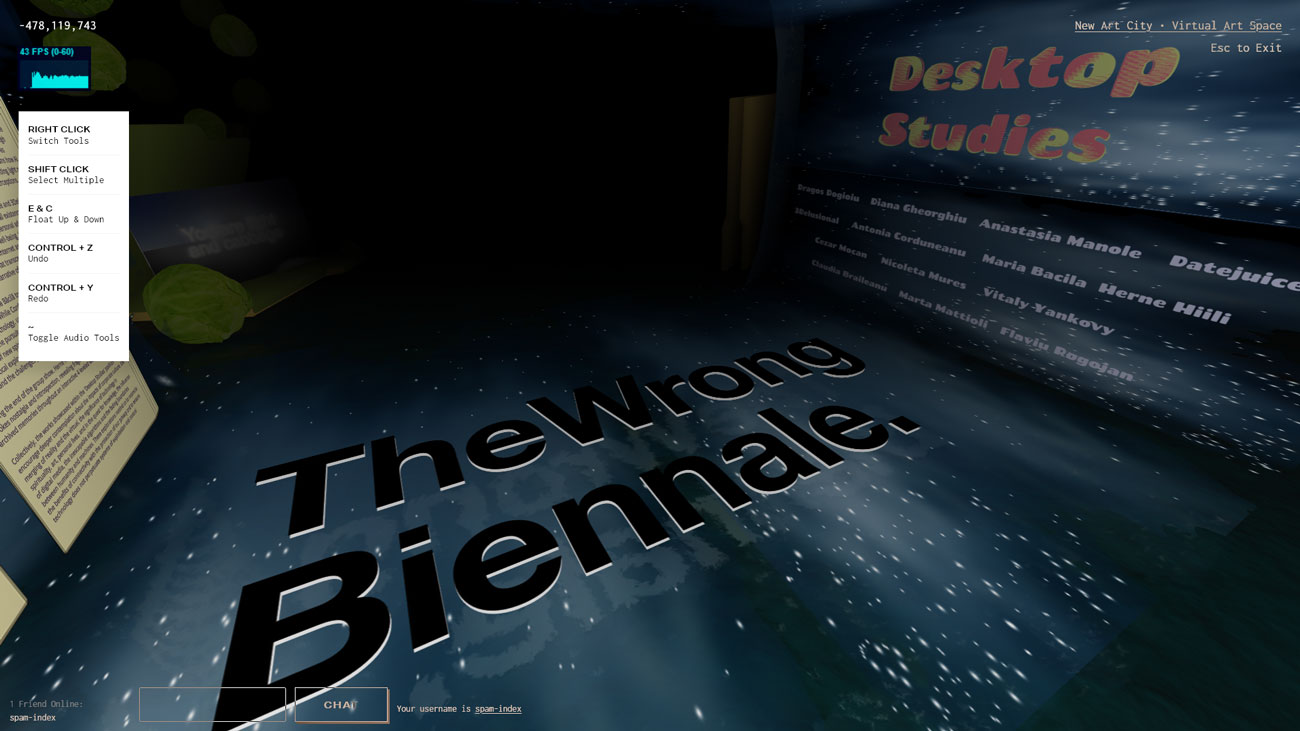
😊 Click here to enter the pavilion! 😊
Cezar Mocan – Human Interface Guidelines (Metaphor)
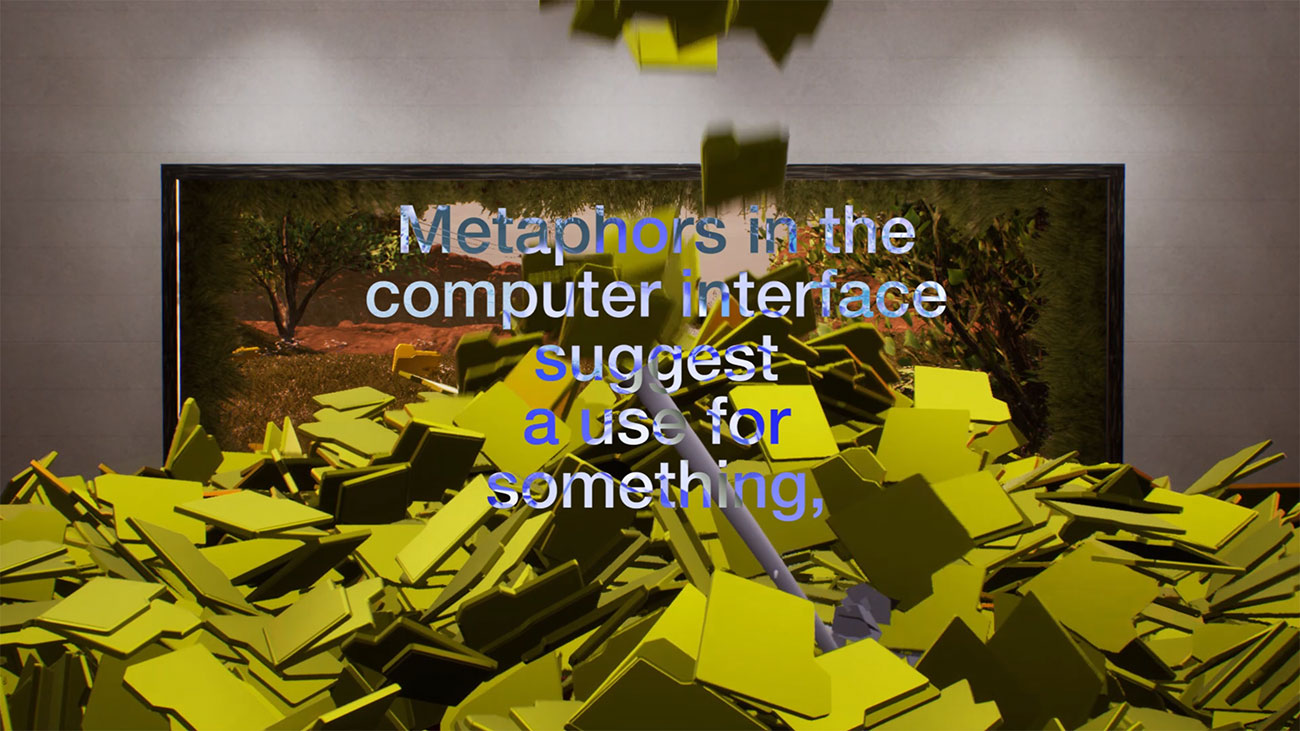
In 1987 Apple published the Macintosh Human Interface Guidelines – a document summarizing the visual principles behind the MacOS user interface. In a pursuit towards popularizing personal computing throughout the 1980s, Apple embraced metaphor as a core idea in interface design: presenting the user with concepts already familiar from everyday life, as a means towards easing the software learning curve.
The desktop metaphor is one popular instance of metaphor usage in interface design. It models a computer’s working area as if it were the user’s desk, viewed from above, and recontextualizes objects found in the office (such as files, folders or trash cans) into digital entities.
This two channel video engages with and reverses the skeuomorphism of the desktop metaphor. The default landscape photograph which serves as desktop wallpaper evolves from visual backdrop to full-blown ecosystem, which is being watched (left channel) and watching (right channel) at the same time. Human presence is not directly portrayed, but implied through the design of the scene – the museum-like setting invites the spectator to project their gaze into the landscape. 3-dimensional models of the folder icon serve as the visual liaison between the two spaces, slowly overflowing the scene throughout the course of the video. Original text by Apple, arguing for the use of metaphor in interface design, is shown on the screen, while elements of nature (trees and flowers) rotate in the center of each channel, in reference to the most popular motion graphics gestures in loading screens.
Human Interface Guidelines (Metaphor), Cezar Mocan
Bio:
Cezar Mocan (b. 1993) is a Lisbon-based artist and computer programmer interested in the interplay between technology and the natural landscape. Using narrative generative systems—animated videos of infinite duration, real-time simulations built in game engines or other software—he creates worlds that recontextualize aspects of digital culture we take for granted, often in absurd ways, while investigating the power structures which mediate our relationship with technology. Cezar holds an undergraduate degree from Yale University and completed his post-graduate studies at New York University, where he also served as a research resident and adjunct professor.
Nicoleta Mureș – Urban Dreams, Coffee Cup Schemes
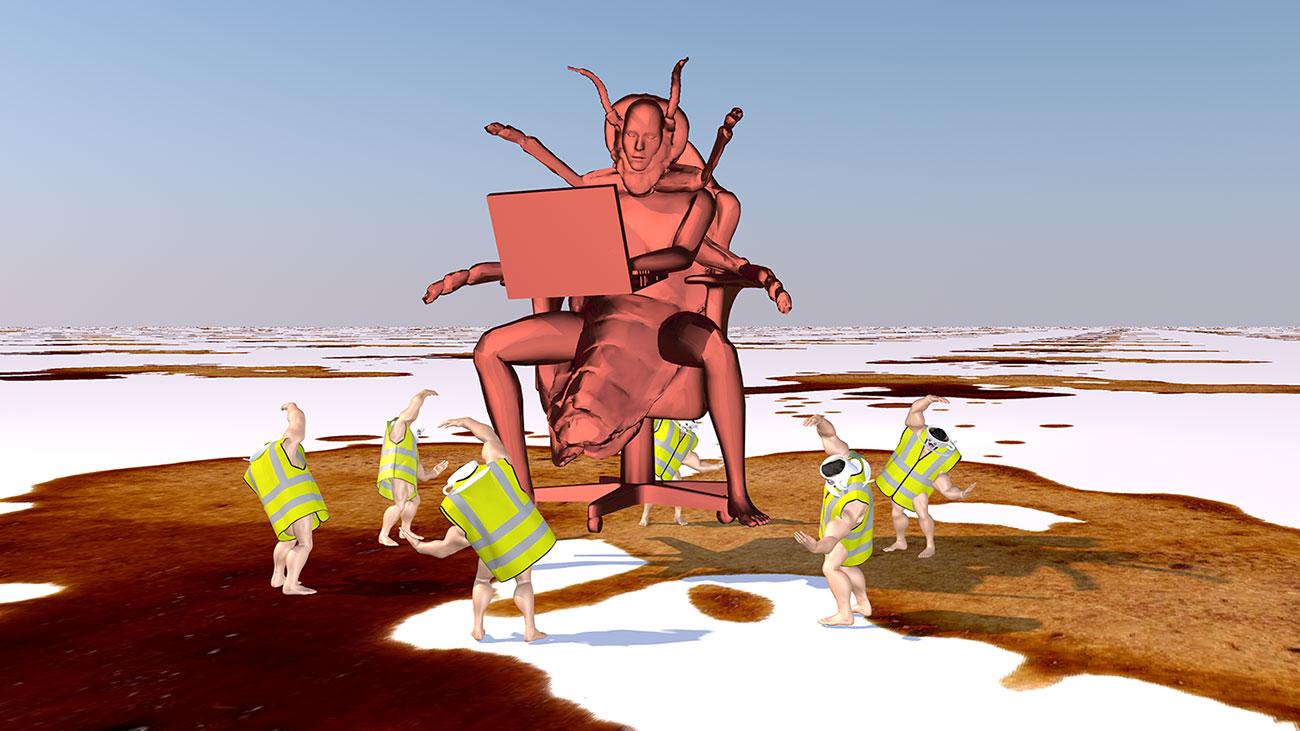
Urban Dreams, Coffee Cup Schemes it is a reimagining of the quintessential computer-worker as a cockroach hybrid, drawing a parallel between these often demonized insects and the individuals who have borne witness to the evolution of Homo sapiens on its technologically-obsessed journey. Cockroaches, survivors throughout history, stand as a testament to resilience and adaptability, akin to those who navigate the complexities of contemporary society. It is here, in this most advanced society of all times, that the harsh reality is revealed: those who work tirelessly, those who are the backbone of this high-tech advancement, are often the very ones who bear the brunt of social inequality.
The dancing characters with coffee-cup heads represent the collective pursuit of distraction from the harsh realities of the productivity culture. These characters “venerate” this culture not out of genuine belief but as a satirical commentary on the unhealthy grind of life, where existence is reduced to mere numbers and descriptions on spreadsheets, and the pursuit of happiness is subsumed by the demands of a relentless corporate machinery.
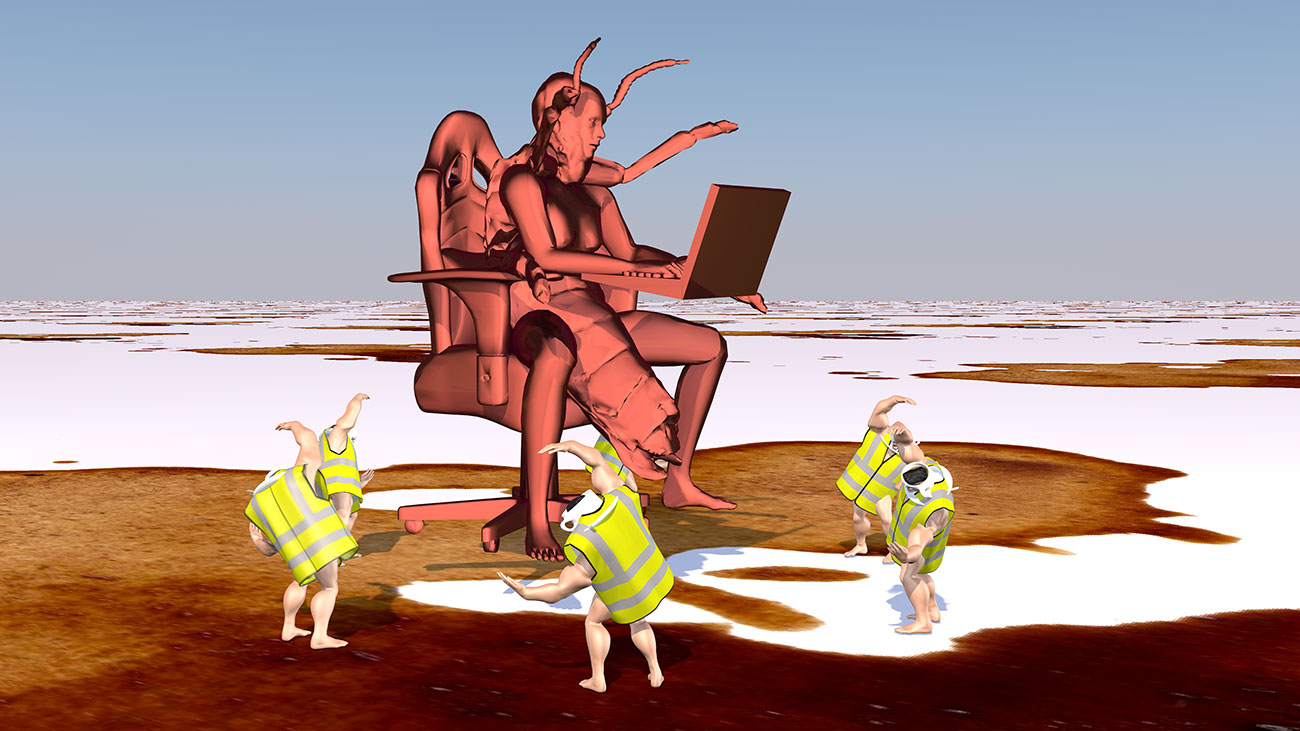
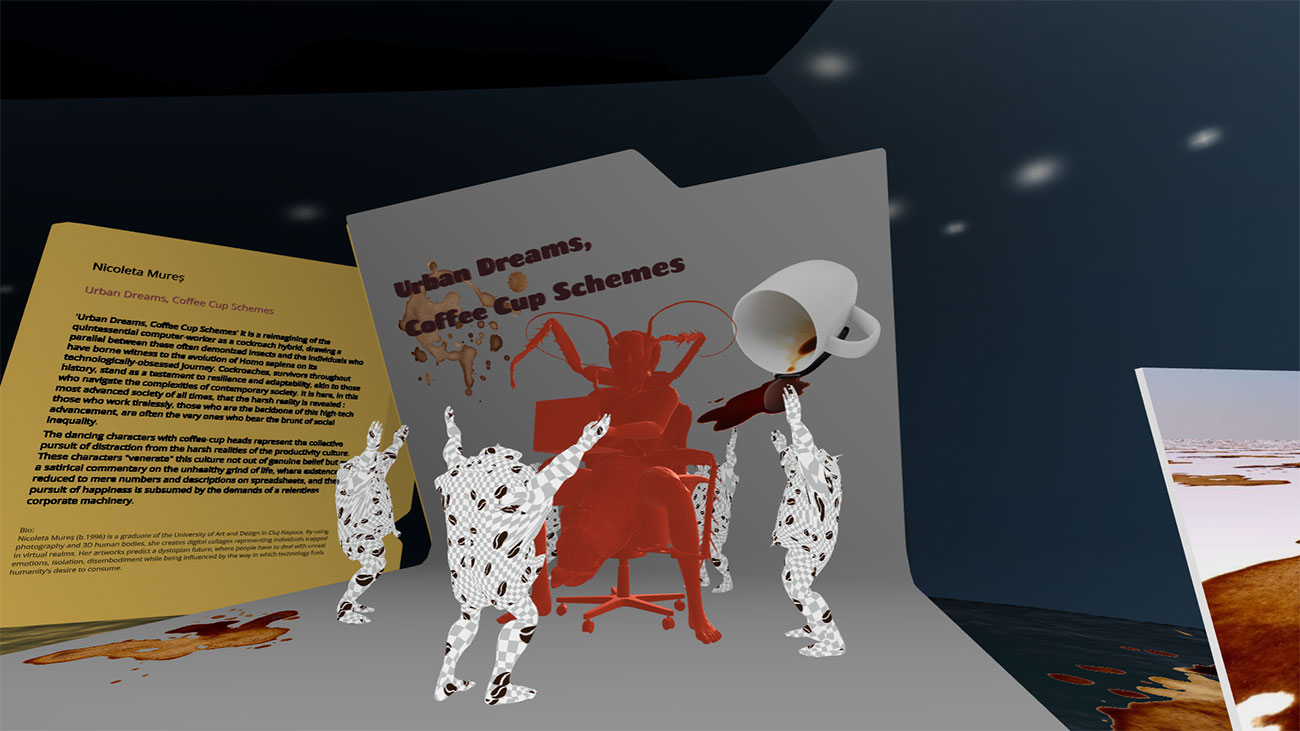
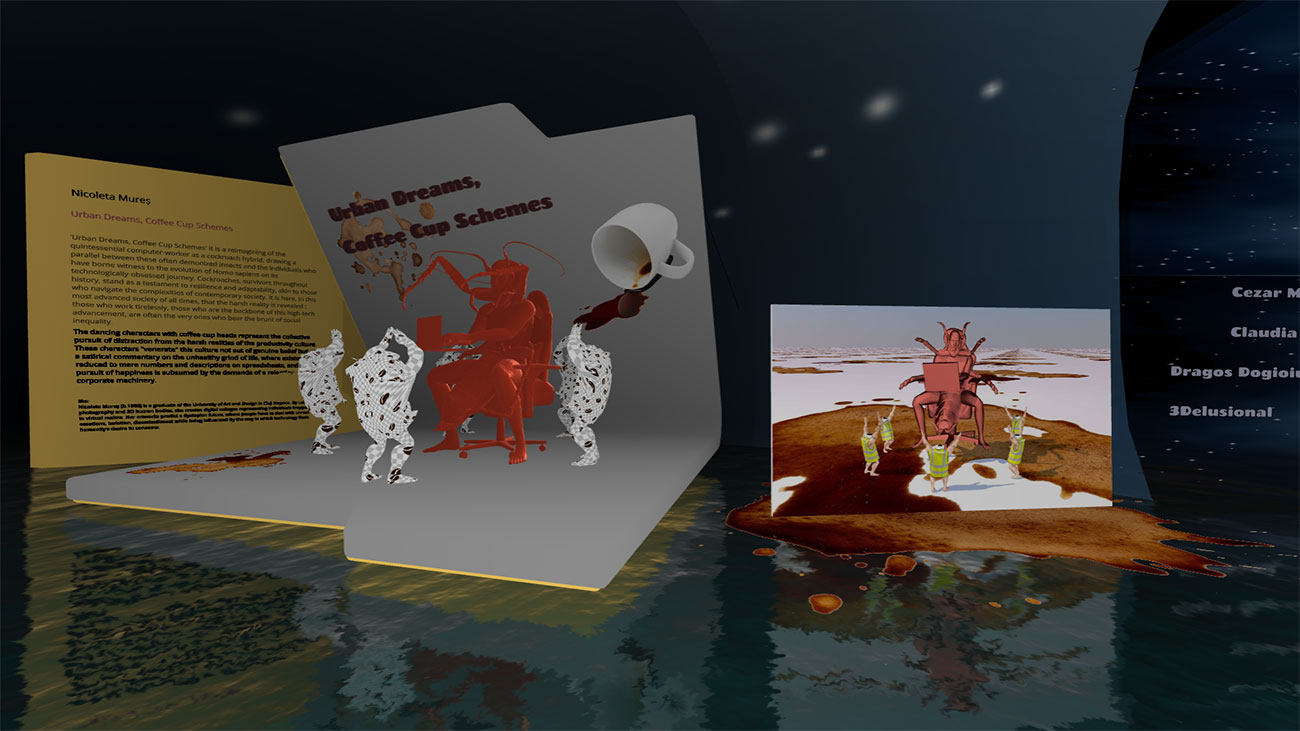
Bio:
Nicoleta Mureș (b.1996) is a graduate of the University of Art and Design in Cluj-Napoca. By using photography and 3D human bodies, she creates digital collages representing individuals trapped in virtual realms. Her artworks predict a dystopian future, where people have to deal with unreal emotions, isolation, disembodiment while being influenced by the way in which technology fuels humanity’s desire to consume.
Vitaly Yankovy – Carcass Nr2
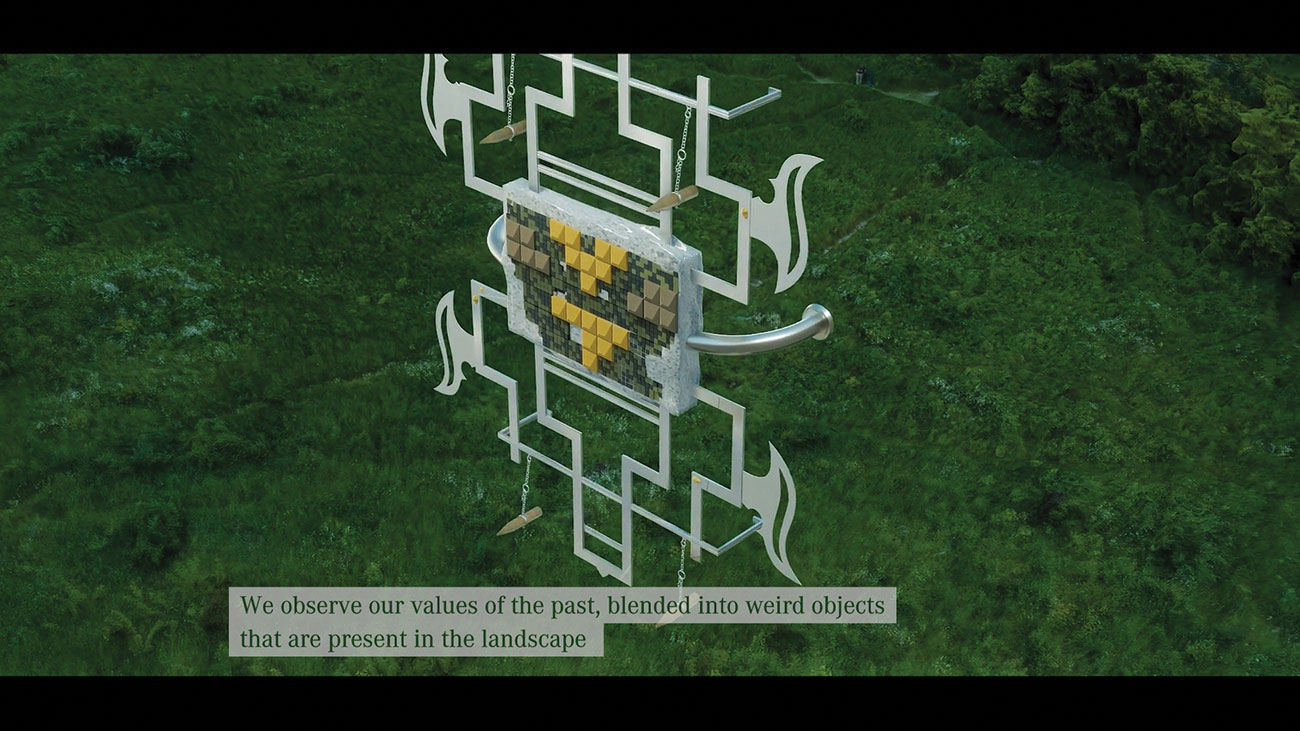
Decorative carcasses on ground floors of Art Deco modernist buildings can be considered as an aestheticization of protection. Protection, security, safety come as a very basic modern function with access limitation, security guards, surveillance cameras, barriers. In such secured spaces like offices and shopping malls, material surfaces come mostly as sterile polished metal and glass details. We observe hybrid security structures in abstract virtual landscapes, including medieval, mid-war, communist and modern elements. These carcasses appear as shapes that lost their direct security function in a post-human environment.
Carcass Nr2, Vitaly Yankovy (in collaboration with Claudia Chiriță)
Bio:
Vitaly Yankovy (Vinnytsia, Ukraine / Bucharest, Romania) is a multidisciplinary visual artist, designer, researcher and experimental musician. Finished Contemporary art course at School of visual communication (Kyiv) in 2014 (curated by Catherina Badianova and Lada Nakonechna). Finished Indie Lab documentary school in Kyiv (2018) and American Art Incubator, organized by Izolyatsia and Zero1 (2020). Works with video essays, animation, 3D, drawing, readymades, sculpture and sound. Artistic practice builds around hybrid landscapes, which consist both of physical and digital objects. Currently interested in creating objects from leftovers of material culture and relations between digital and material matter through optics of non-human and post-human studies.
Claudia Brăileanu – 360° Stereoscopic Landscape Painting
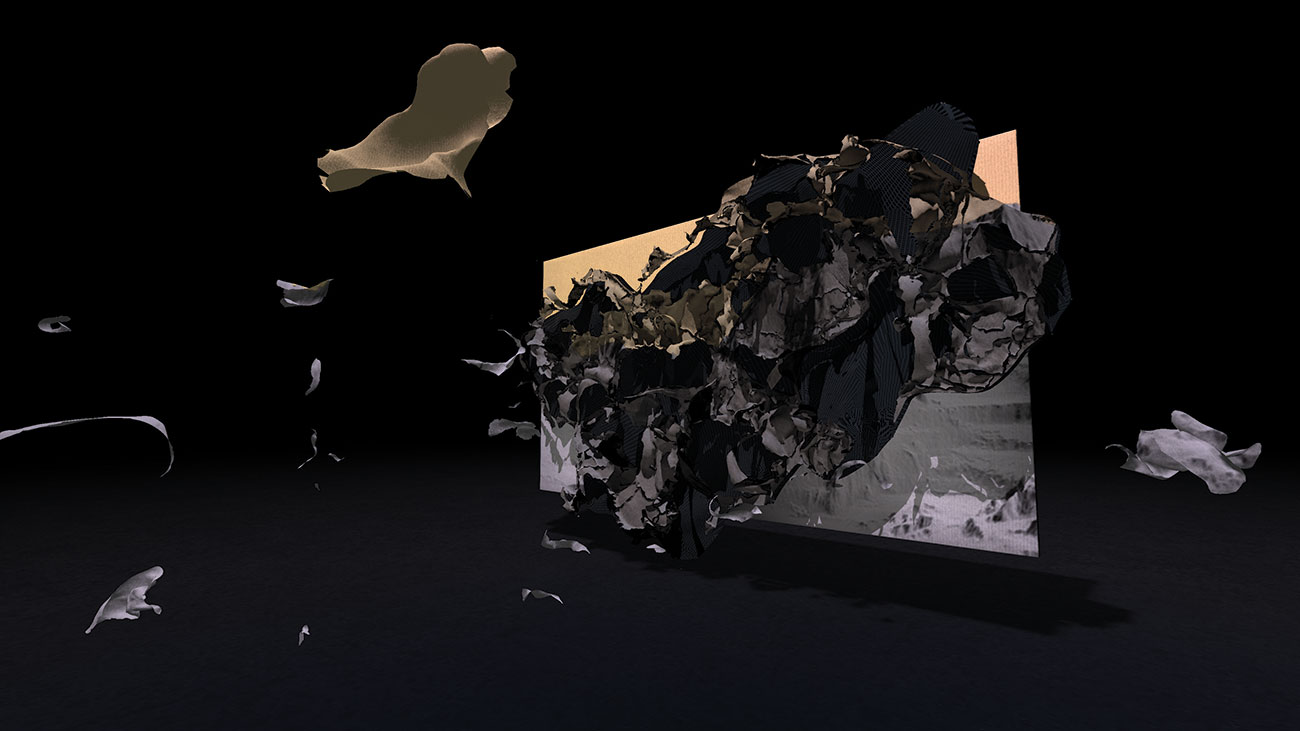
😊 Click here for pavilion view! 😊
360° Stereoscopic Landscape Painting explores the intricate ways in which digital technologies shape our perception of the natural landscape, as well as how we engage with various portrayals of the natural world through digital devices. At the center of this exploration lies a landscape painting – a synthesis of an imaginary landscape and a 3D scan of a physical terrain. The painting can be experienced in multiple digital settings, each unveiling its distinctive characteristics as well as its limitations. This painting takes on various forms, functioning as an interactive object, a static object, or a video that provides insights into its creation, serving as a visual description and commentary on its origin and materiality.
Highlighting differences through repetition underscores the central theme of the work: evolving perceptions within diverse digital environments. This exploration delves into the process of shaping experiences through multiple interactions with objects and examines how the context in which we encounter these objects influences our understanding. The recurring experience of the painting in various digital settings highlights the unique attributes and limitations of each environment, which are also mirrored by the painting. Whether it’s an individual experience in a desktop web browser, a multiplayer exhibition accessible on computers and mobile devices, or a virtual reality environment, each form of engagement provides a distinct perspective.
The work also contemplates the influence of digital technology on the realm of painting and how our interactions with digital objects might potentially reshape established conventions concerning our engagement with artistic objects in the physical world.
360° Stereoscopic Landscape Painting, Interactive Software Application for Desktop Web Browser, 2023, Claudia Brăileanu
😊 Click here for full screen view! (PC / laptop only) 😊
Bio:
Claudia Brăileanu is a Romanian transmedia artist based in Bucharest. Drawing on her background in painting, she produces works that investigate how digital technologies are influencing and shaping the medium of painting. She develops a visual vocabulary that enables her to explore and describe the interplay between the physical and virtual realms and its impact on our perception of painting. She sees the medium as a valuable resource to understand the intricate ways in which digital technologies are transforming our engagement with the world.
Her practice encompasses painting, 3D digital animation, virtual reality, augmented reality and digital prints.
Marta Mattioli – A hundred years I’d die for you
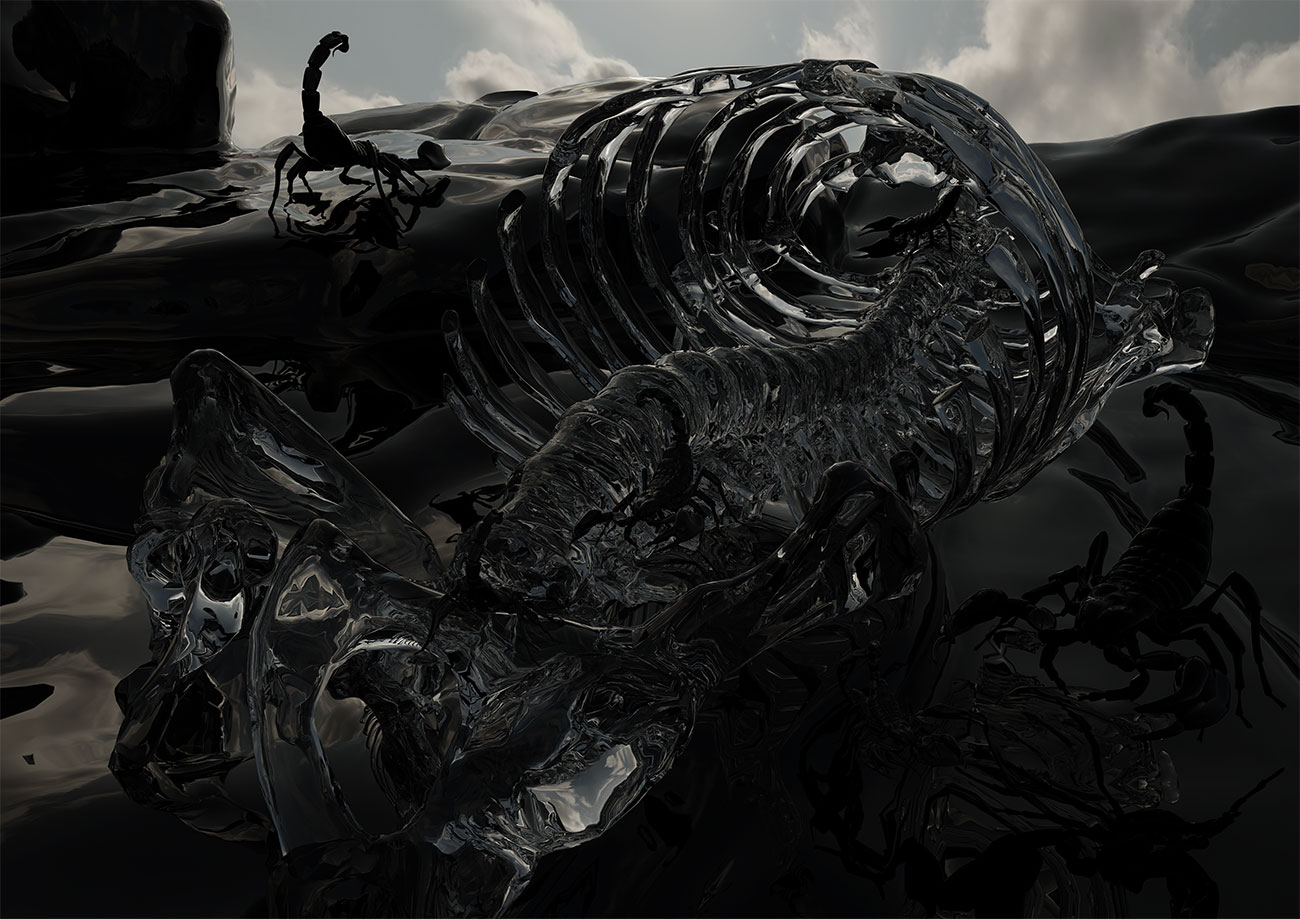
A hundred years I’d die for you acts as a starting point to delve into the exploration of the profound relationship between the organic and the digital domains. This concept aims to investigate the transcendence that occurs when the organic and digital realms converge, blurring the boundaries between them. The organic-digital relationship signifies the interplay between the inherently human qualities of emotions, experiences, and consciousness, and the ethereal nature of the digital landscape. It is an exploration of how these two seemingly distinct realms intertwine, influence one another, and potentially transform our understanding of existence.
The concept centers around the idea that the organic and the digital are not separate entities, but rather interconnected facets. It questions the traditional dichotomy between the tangible and the virtual, suggesting that their convergence leads to a new realm of perception and understanding. The ground from which I start is a state of uncertainty, which I think is chained to our behaviour. The future past, as a possible reality, takes the concept of evolution defined by nature, human, and digital relations through the extreme of becoming a hybrid of materialities. Inspired by Rosi Braidotti’s concept of becoming machine, becoming ground and animal, I choose to manufacture this idea by playing with the materiality of what we know as being “normal”, metamorphosing they’re origin.
Exploring the human relationship with devices becomes an integral part, it delves into the evolving dynamics between humans and technology, highlighting the impact of devices on our perception, identity, and interconnectedness. At the heart of these artworks lie organic forms, embodied by chains, delicately interwoven strands, or sinuous shapes. These elements symbolize the fluidity, growth, and interconnectedness found in nature and human experiences. They evoke a sense of vitality, movement, and the complexity of organic life. Contrasting with the organic, the metallic materials in the artworks embody the industrial and technological aspects of our world.
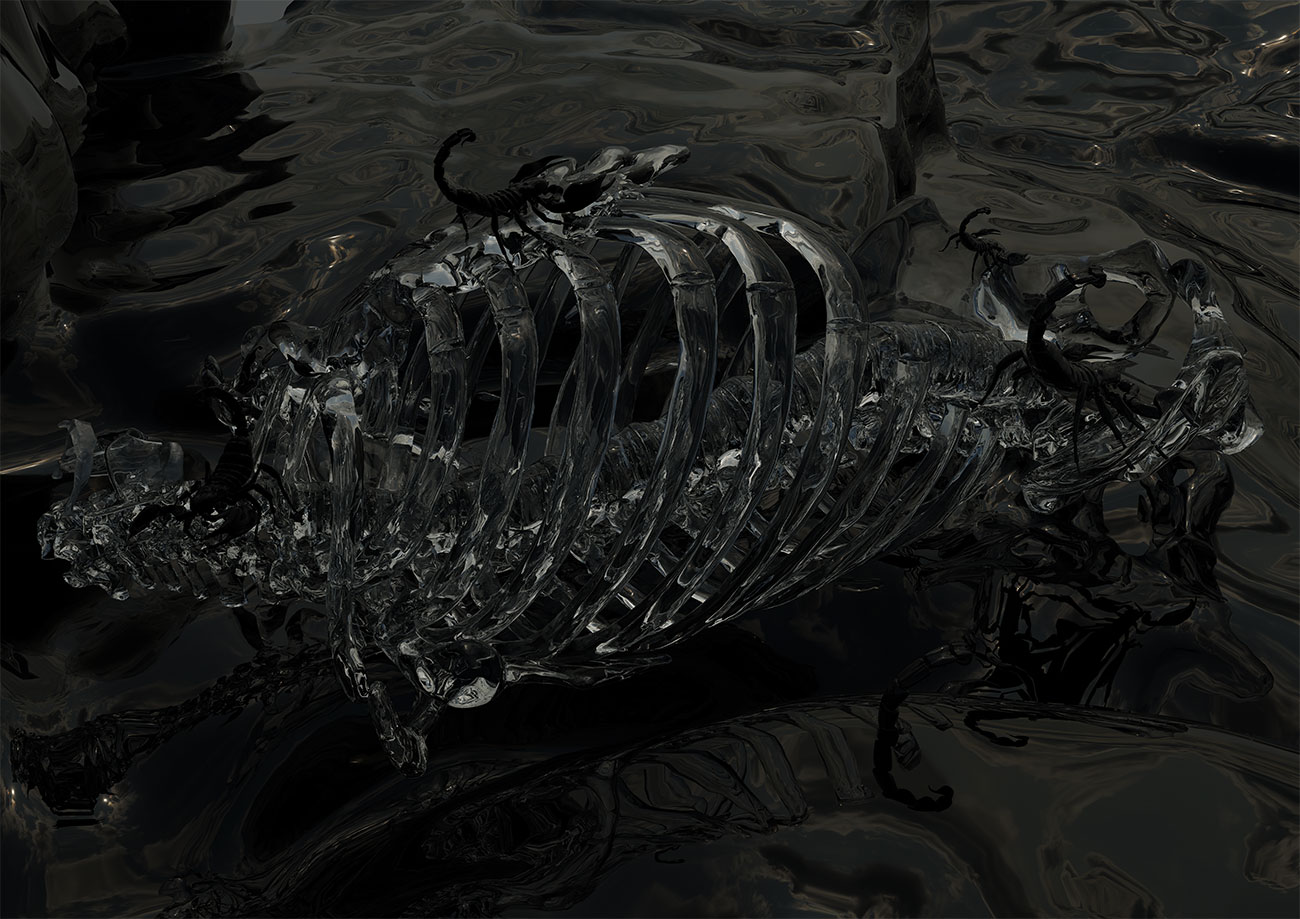
Bio:
Marta Mattioli (b. 1998, Sansepolcro, Italy) is a visual artist with double origins, rooted in Romanian and Italian culture. Her practice is based on the diversity of available mediums and by the coexistence of digital and physical reality. The artist is also a young Kinema Ikon & Atelier 35 member, currently living and working in Bucharest, Romania. Mainly working with the 3D medium, her work is meant to recreate a reality stuck between utopia and the dystopic possibilities of the future, approaching concepts that define the organic – digital hybridization.
Flaviu Rogojan – In Orbit
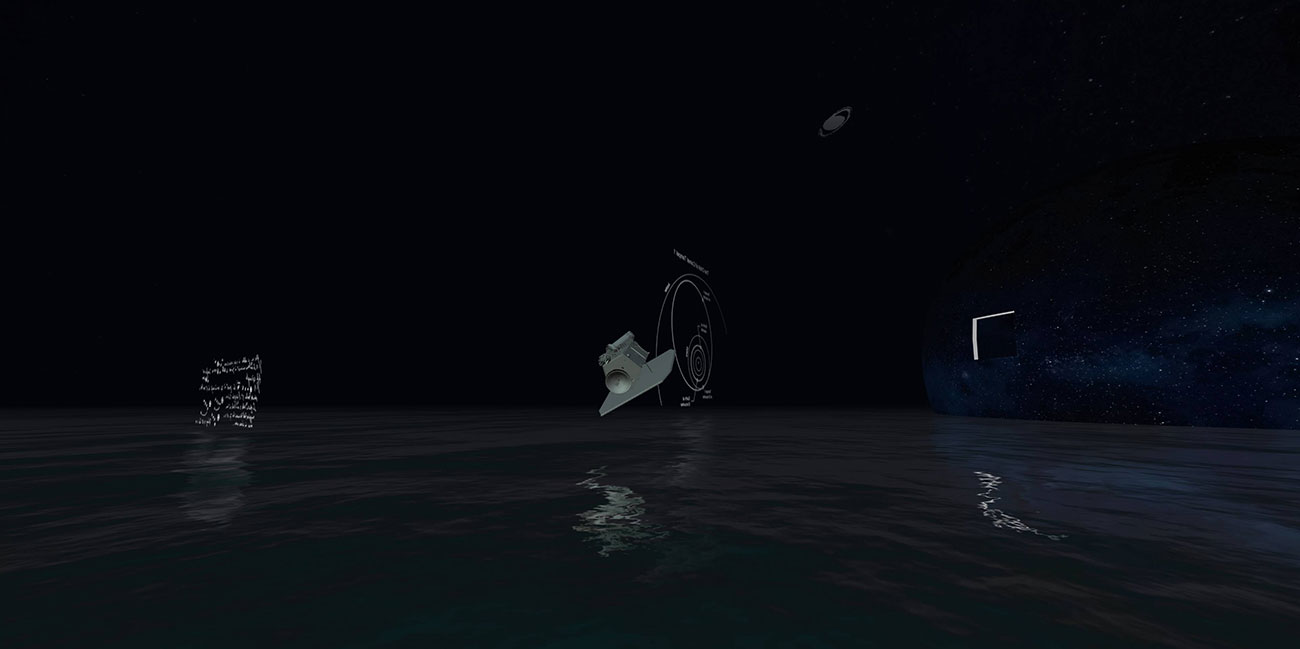
😊 Click here for pavilion view! 😊
Does a robot’s death make it, somehow, feel more ‘human’ to us? Based on the real-life story of a space probe NASA lost contact with in 2013, Flaviu Rogojan’s project blends scientific fact and speculative fiction to imagine the probe’s current existence and newfound life in orbit. The story brings together topics such as the colonial history of timekeeping, the history of comet discoveries, the biographies of amateur astronomer Ernst Tempel and surrealist artist Max Ernst, and the fate of space probes.
In Orbit, Audio story & website, ink drawings, sourced images, sound, music, 2023, Flaviu Rogojan
😊 Click here for full screen view! 😊
Bio:
Flaviu Rogojan, based in Cluj, Romania, is a multi-disciplinary artist and curator. He explores the complex and intertwined nature of our online and offline lives through his work, drawing on influences from science, technology, video games, and Internet culture. In his practice, he merges obscure information and geeky tales with conceptual art techniques to craft fictions and commentaries on current political issues.
Dragoș Dogioiu – Latent News
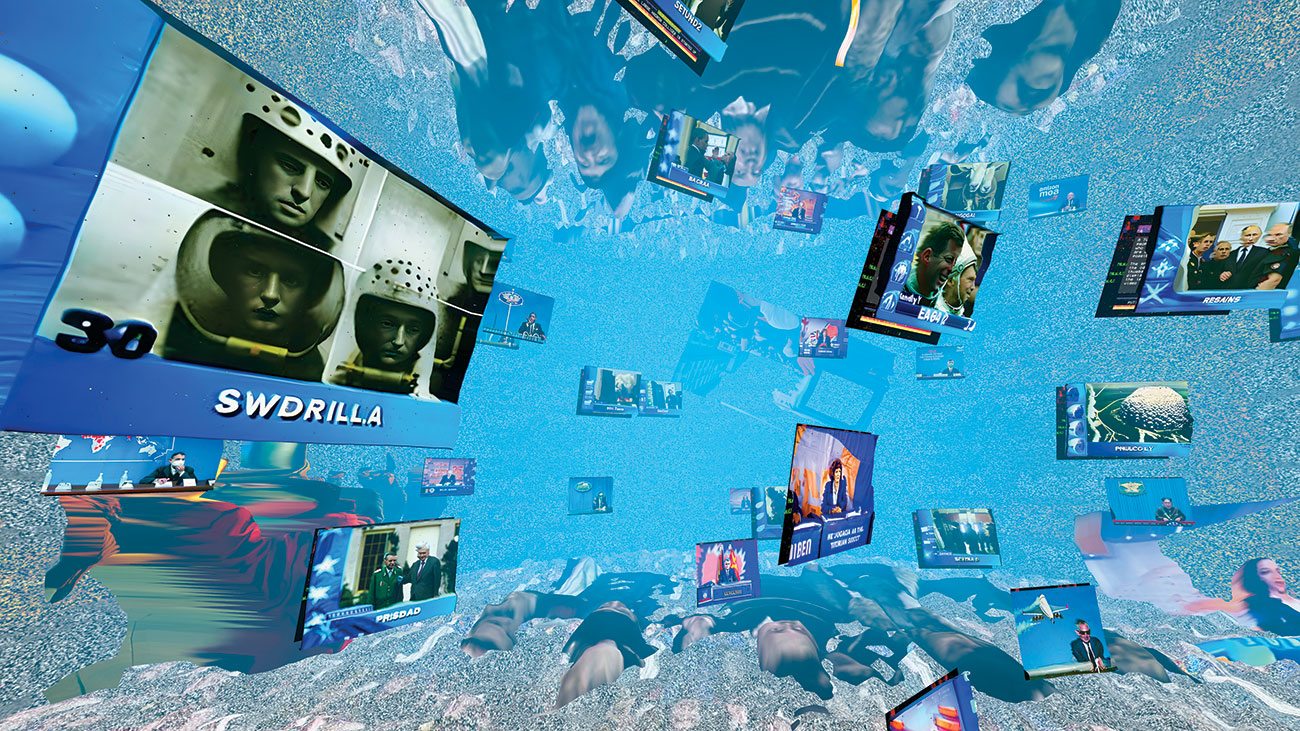
Latent News examines the multidimensional latent space used by artificial intelligence models in order to generate images. Using the Stable Diffusion AI, static frames belonging to real news programmes, such as the TVR broadcast during the 22nd of December 1989, are re-contextualized. Through a series of prompts, the frames are transformed into other significant historical events. Sequences of teletext interwoven between the images show an AI description of the visuals in the form of teletext.
Bringing together the past and the future, as well as building a bridge between analog and digital aesthetics, Latent News shows an AI perspective on the flow of information and time, with its often disjointed characteristics.
Latent News, 2023, video fragment, Dragoș Dogioiu
Bio:
Dogioiu Dragoș-Ion is a New-Media artist interested in XR and animation, currently active in Bucharest. As a member of Kinema Ikon, he has collaborated with them in a number of exhibitions and workshops. He has also worked with museums, private galleries and cultural institutions, including the Ars Electronica Centre Linz where he participated in a group exhibition in 2022.
He is currently a teacher at the CINETIc Center in Bucharest, where he teaches subjects related to VR, AR and world-building.
Diana Gheorghiu – You Are Light and Cabbage
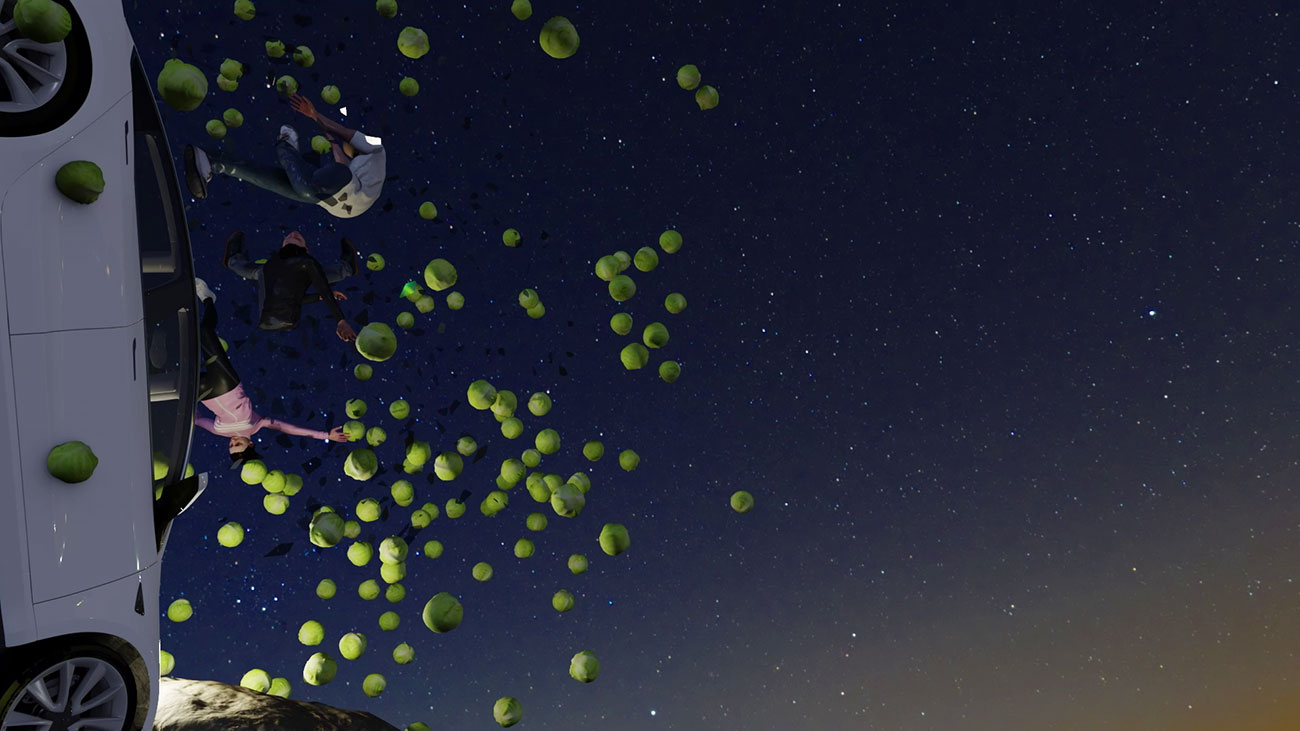
You Are Light and Cabbage, 2023, is a video dedicated to a wellness influencer symbolized by a cabbage head. The project aims to illustrate how social media is being exploited to spread misinformation, COVID conspiracies, and far-right ideologies by engaging in discourse rooted in magical thinking. In the video work, Cabbagehead’s message is addressed to its three followers: the yoga mum, the entrepreneur and the tennis player, each one referring to an existing character in real life. The characters are shown travelling in a car filled with cabbages and crashing into a rock in the desert. They die and so they meet their deity, a cabbage head, who preaches them about reconnecting with nature, harnessing their inner strength, cultivating positive thinking, trusting their intuition, and letting themselves be guided by the law of attraction. The project also explores the notion that online influencers are a new type of clergy for millennials, whose belief system encompasses elements such as politics, self-optimization, therapy, wellness, or astrology.
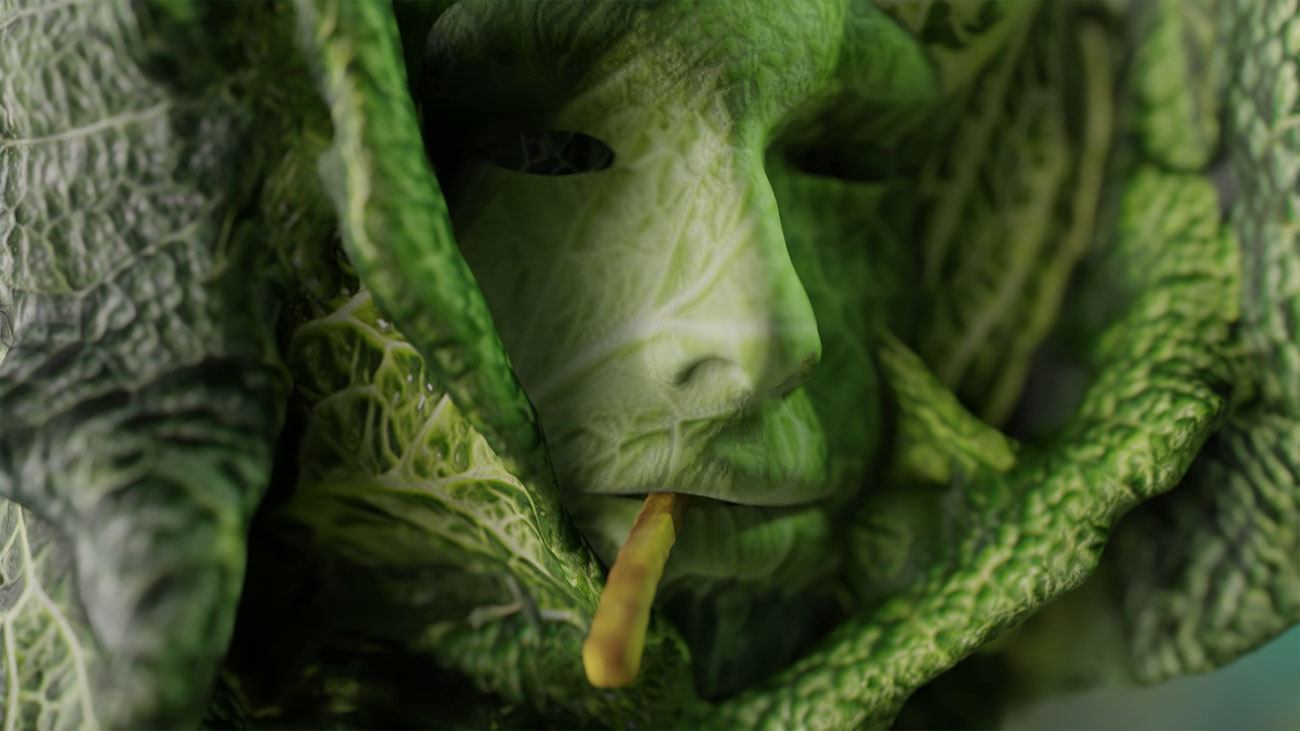
Bio
Diana Gheorghiu uses computer generated characters to explore the topics of self-care, new food, and the wellness industry. Her work follows on from her research into online communities that promote healthy lifestyles. Her research takes place within the philosophy of the wellness industry that has undergone a subtle shift from social to individual responsibility. Diana’s work criticizes the pressure placed on the individual to lead a healthy life and the accompanying feelings of guilt and anxiety and a lack of belonging. For this exhibition Diana creates a digital influencer who invents and sells their own practice, demonstrating how easy it is to construct a wellness methodology within an online community.
Anastasia Manole – Different Stages of Beautification
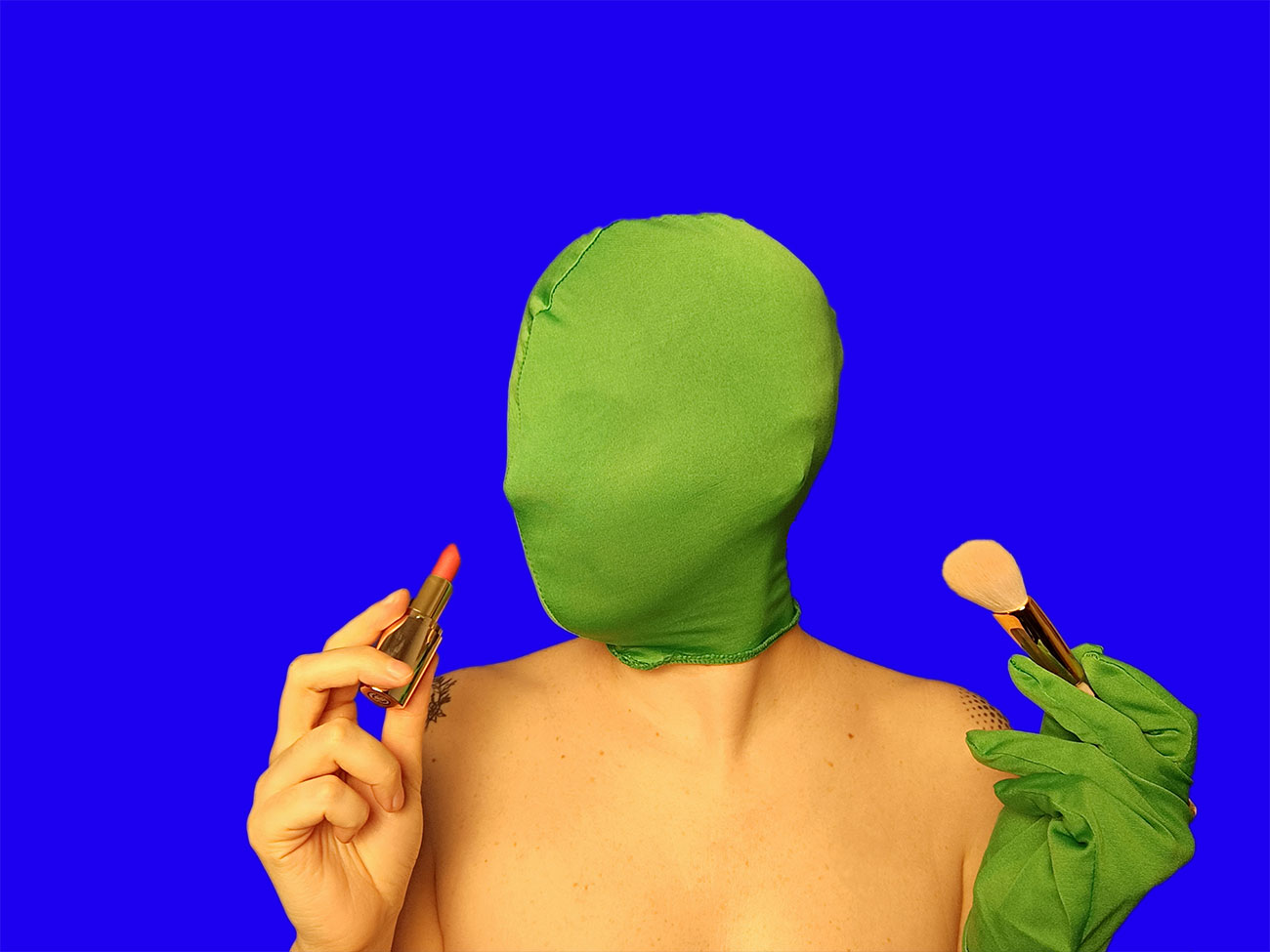
The Different Stages of Beautification serves as a thought-provoking exploration of how artificial intelligence (AI) influences our perceptions of femininity and identity, shedding light on the complex interplay between technology and societal perceptions.
The first video is an AI animation, created from the input that was written as a description: a woman putting on make-up, in the style of watercolor. The AI autonomously decided to put a beauty filter on, in contrast to other specification that were tested before as: a woman touching her face, a woman touching herself, a woman looking in to the camera. Anastasia voluntarily decided to feed the machine learning algorithm her personal data to test the results using her own face using a small part of another of her works, emphasizing the technology’s power to either reinforce or reshape societal beauty ideals.
Different Stages of Beautification – a woman putting on make up</>, Anastasia Manole
The second video represents the artist`s head and hand covered in green screen costume putting on make-up. This imagery opens up a world of possibilities for reshaping and customizing one’s identity. The absent body parts represent placeholders for potential transformations, driven by AI and sourced from the vast expanse of the internet.
The work addresses the pervasive trend of beauty filters embedded within phone cameras by default, as you need to go to the General Settings on your phone to deactivate it. Many individuals unconsciously and unknowingly adopt these filtered images as their self-image, leading to a dissonance between how they perceive themselves through their own camera and their unaltered appearance in other people`s photos. This dissonance can induce feelings of dysphoria, as Caroline Mimbs Nyce wrote for The Atlantic, AI will create beautiful humans without any description even being given to it, as more and more edited images are being fed to it.
The notion of the green screen face serves as a canvas for self-creation, exemplifies the potential of AI and internet-sourced imagery as blueprints for constructing online avatars or even guiding decisions related to plastic surgery.
Different Stages of Beautification</>, Anastasia Manole
Bio:
Anastasia Manole , the digital avatar of artist Gabriela Mateescu, employs a unique approach to her creative work. She uses a combination of stock images, Google-sourced visuals, and YouTube video clips, relying on basic montage and editing skills.
One of the core themes explored by Anastasia Manole is the online environment. She delves into this subject through video and installations, with a particular interest in post-feminism and the online experience from a woman’s perspective. Her work examines how the virtual realm has, for many, become the primary reality, and as a result, the distortion of images to the point of absurdity no longer sparks doubt. This concept reflects the profound impact of the internet on our perception of reality and the blurring of the lines between the physical and the digital.
Anastasia‘s artistic style is characterized by her playful use of stock materials. She overlays these elements into bright, colorful collages that often traverse the border between kitsch and naive art. This playful approach, the intentional fragmentation and unfinished quality of her pieces can be seen as a commentary on the aesthetics and visual culture of the internet. This commentary highlights how art, in the digital age, often mimics reality so closely that it becomes challenging to distinguish between the two. It speaks to the altered perception of reality online, where “truth” is often accepted without physical evidence.
Notably, Anastasia is also a co-founder of spam-index.com.
Datejuice / Irina Bako – TikTok Nightmares
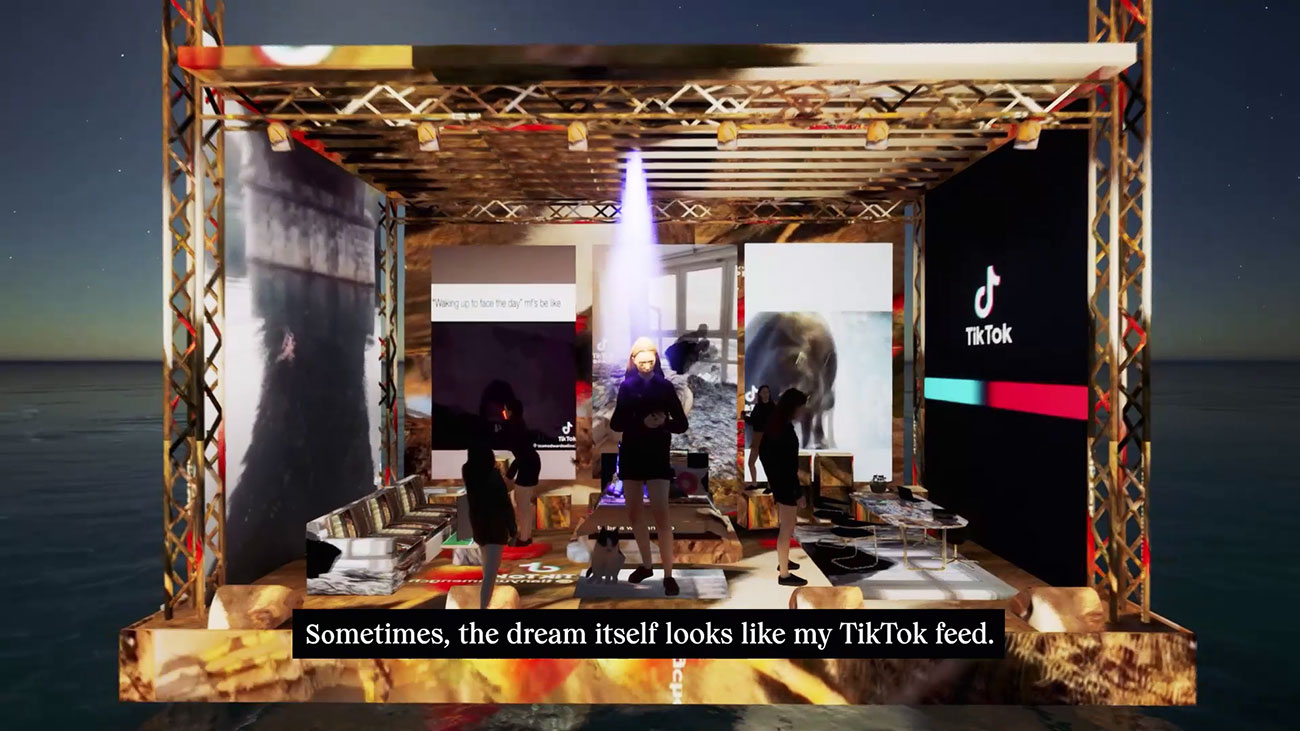
This lucid dream is born from the author’s own reality, who spends at least an hour every night on TikTok before going to sleep. It is a manifestation of how content addiction has deeply infiltrated her subconscious desires, like a kind of digital microplastic, completely blurring the boundaries between real life and the virtual world and exacerbating the author’s preexisting mental health issues.
TikTok Nightmares, Datejuice / Irina Bako
Bio:
Irina Bako , also known as Datejuice, started learning 3D on her own in 2020. In the meantime, she has worked on several artistic and commercial projects and has had several art exhibitions throughout Romania. The multiple female characters she creates serve as symbolic interfaces for her emotions and thoughts.
Her digital landscapes and portraits usually depict dreamscapes, memories, imaginary fashion models or cute but weird beings. Her work is filled with tongue-in-cheeck visual fetishes: humanoid models in revealing clothes, special objects or distinctive poses that she invests with symbolic and emotional value, creating a performative 3D ‘shot’.
3Delusional / Ema Motea – I had this dream again!
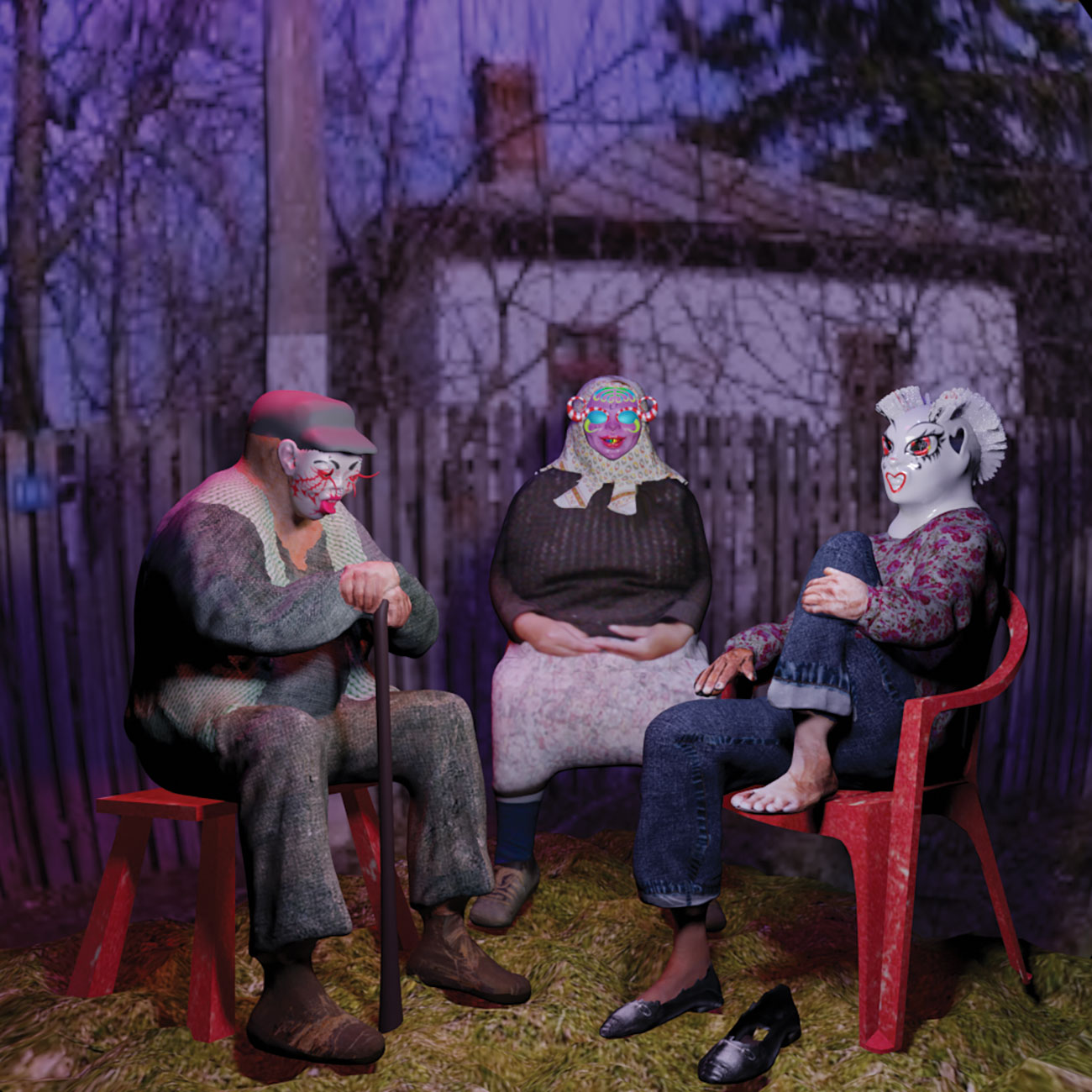
I had this dream again!, 2023, video still, 3Delusional / Ema Motea
I had this dream again! is a 3D animation that illustrates the concept according to which the timeless internet becomes an archive of human experiences. Memories, thoughts, and individual contributions are preserved indefinitely, becoming part of a digital legacy that transcends generations. Consequently, each individual contributes to a collective narrative of humanity where the boundaries between real and virtual blur, stretching into a future without strict temporal limits.
I had this dream again!, 3Delusional / Ema Motea
Bio
3Delusional is an online alias adopted by Ema Motea (b. 1998), a 3D artist based in Bucharest. She is a graduate of The National University of Arts Bucharest and is currently experimenting with 3D art and interactive installations. Her work delves into the intricacies of conflicting relationships that unfold at the crossroads of societal norms and personal freedom. She employs the virtual realm as a canvas for storytelling, navigating the landscape of an evolving digital culture that is steadily assuming the role of the dominant cultural force.
Through the use of whimsical, ironic, and playful aesthetic nuances, Ema Motea‘s artistic practice endeavors to challenge conventional narratives. Her approach is marked by a commitment to introducing fresh, flexible, and expansible perspectives, inviting audiences to reconsider the boundaries of the ordinary.
Antonia Corduneanu – Forgive me Father, for I have seen
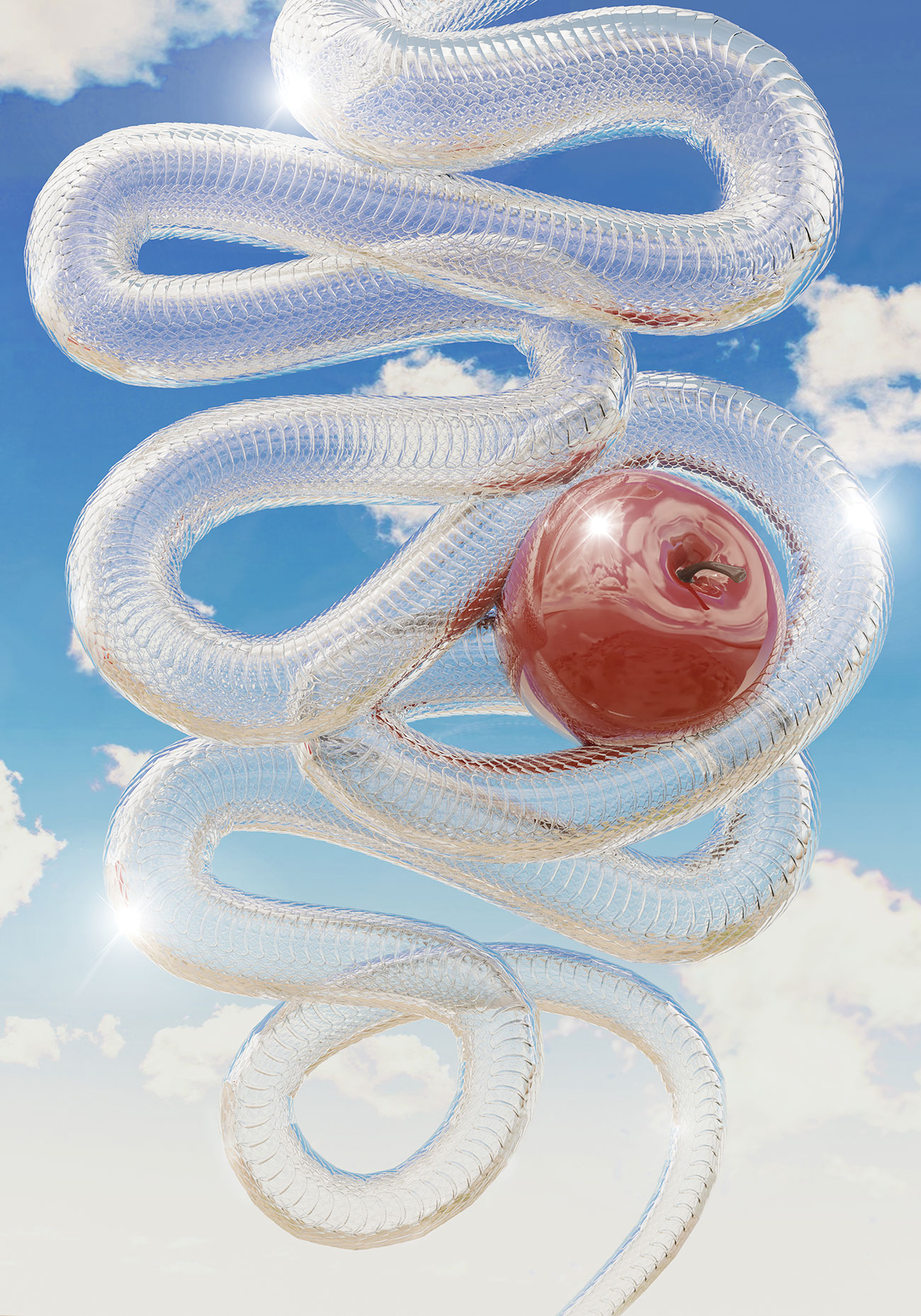
😊 Click here for pavilion view! 😊
The artwork proposes a reexamination of the Christian founding myth from a contemporary perspective, focusing on two key symbolic elements: the Serpent and the Apple. Personal research into pre-Christian religions has revealed that these two symbols have been fundamental in numerous traditions, legends, and beliefs dating back to ancient times. The shedding of the serpent’s skin has made it a symbol of transformation, rebirth, and wisdom.
The title Forgive me Father, for I have seen alludes to the understanding of the good and evil through the awareness of the duality of our subjective existence. The phrase reflects the discovery of the “truth” about serpents, which, although perceived in Christianity as symbols of temptation, chaos, or hell, can have diametrically opposite meanings in other mythologies. There are vast differences in the accounts of similar events, depending on the source. These discrepancies draw attention to the inaccuracies and underscore the need for vigilance. In essence, the artwork is a reflection on the meaning of truth and the human need to seek it, regardless of consequences.
Forgive me Father, for I have seen, Antonia Corduneanu
Bio:
Antonia Corduneanu (b. 1994) is a multidisciplinary artist, constantly seeking new challenges in each project to expand her skills and knowledge. She has been practicing graphic design for over 7 years, with experience in branding, illustration, typography/lettering, posters, packaging, and editorial work. After completing her bachelor’s and master’s degrees at the University of Art and Design in Cluj-Napoca, she has participated in various collective art and design exhibitions and organized a solo exhibition, “If your species disappears clap your hands,” at CAV Multimedia, Bucharest, in 2020. Her work is inspired by the intersection of technology and nature, futurism and ancestral themes, conveying the essence of concepts through clear lines and metallic textures.
Maria Băcilă – 。 ゚•┈୨♡୧┈• ゚。 Welcome to My Page, I Hope You Have Fun: Being a Girl Online ‧₊˚✩彡
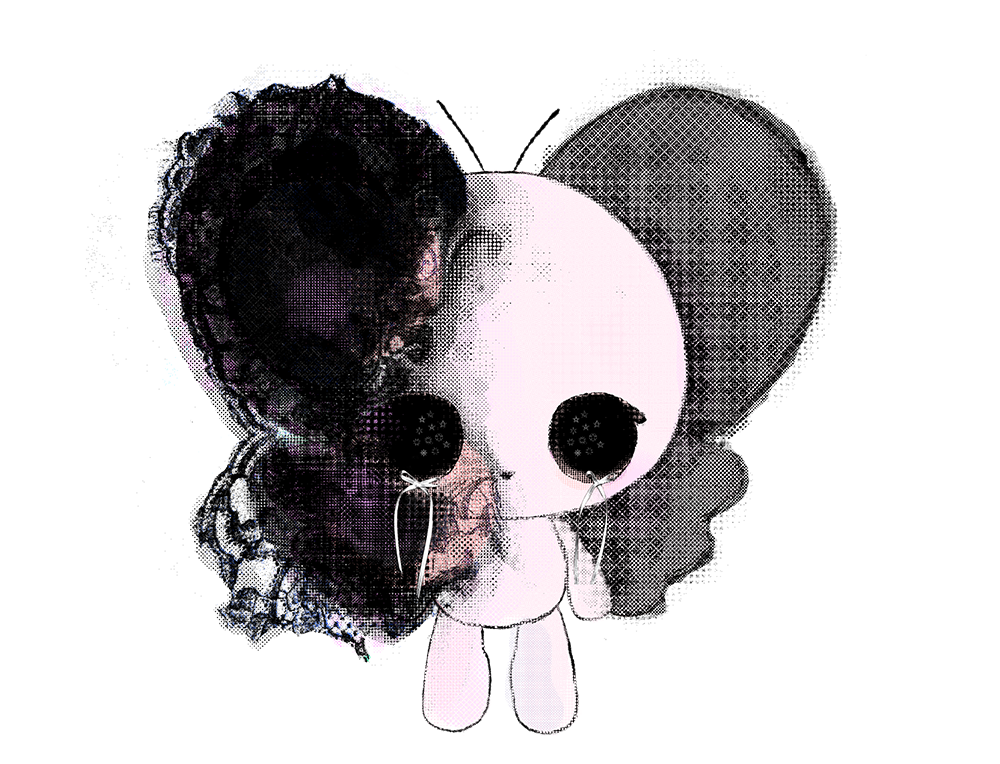
😊 Click here for pavilion view! 😊
The internet is becoming a popular source for spiritual exploration, especially in the context of the breakdown of traditional institutions and the challenges of the pandemic era. This has led to the emergence of new spiritual beliefs and mythologies, often blending ancient traditions with contemporary internet references and remix culture. While some may view this as absurd or ironic, it reflects a deep human need for meaning and purpose in an increasingly complex and fragmented world. The internet’s ability to derealize and dissociate also makes it an accessible portal for reaching religious ecstasy. Ultimately, this emerging paradigm represents a departure from the rigid certainties of the past and a bold exploration of new frontiers of the mind and spirit. And I am in the middle of it all, just a girl being online. I am just channeling. I am just a vessel. That’s all. I am just going seraphim mode.
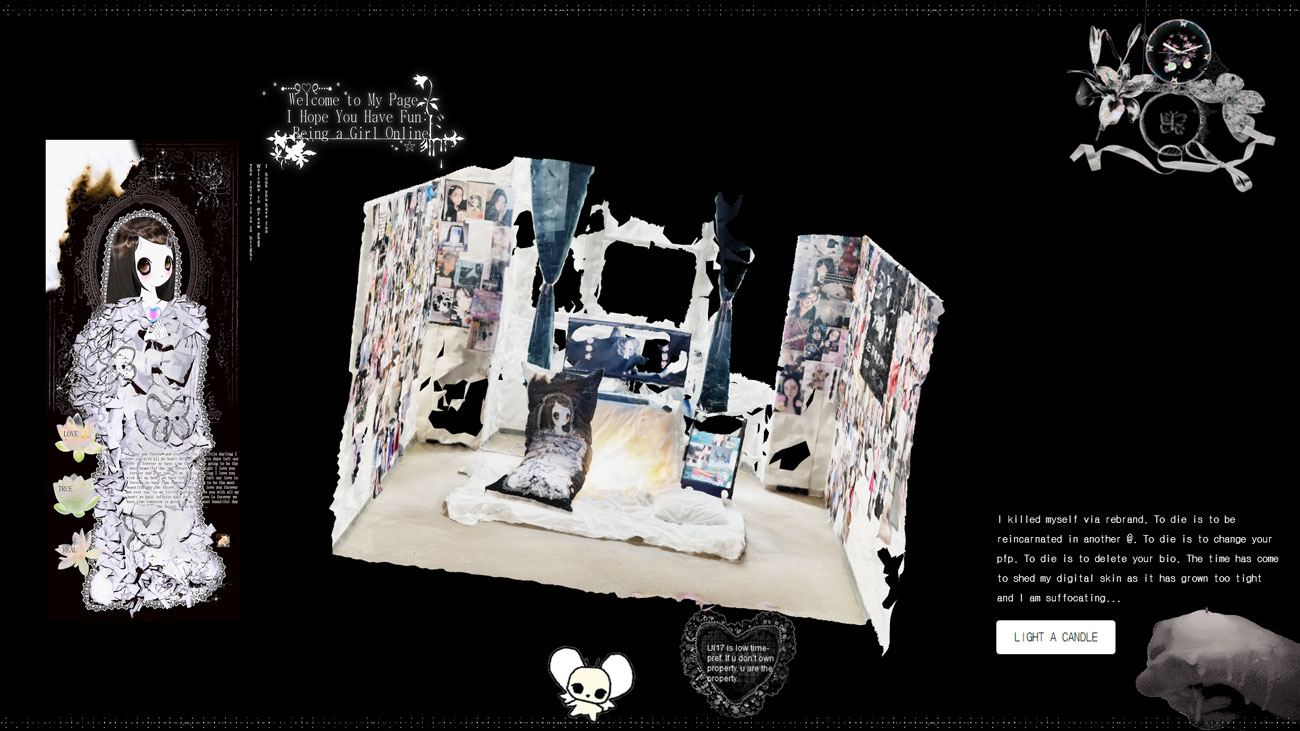
😊 Click here for full screen view! 😊
Bio:
Mari is a visual artist from Transylvania. Her work is hyperstitions and code writing as magic, worldbuilding and reality shaping, using faith as an operating system, Love, truthmaxxing, network spirituality both IRL and online, and prayer-posting. She memed her way to the True and the Real. Her and her work are a sincere reflection of being and being online.
Herne Hiili – Desktop Studies
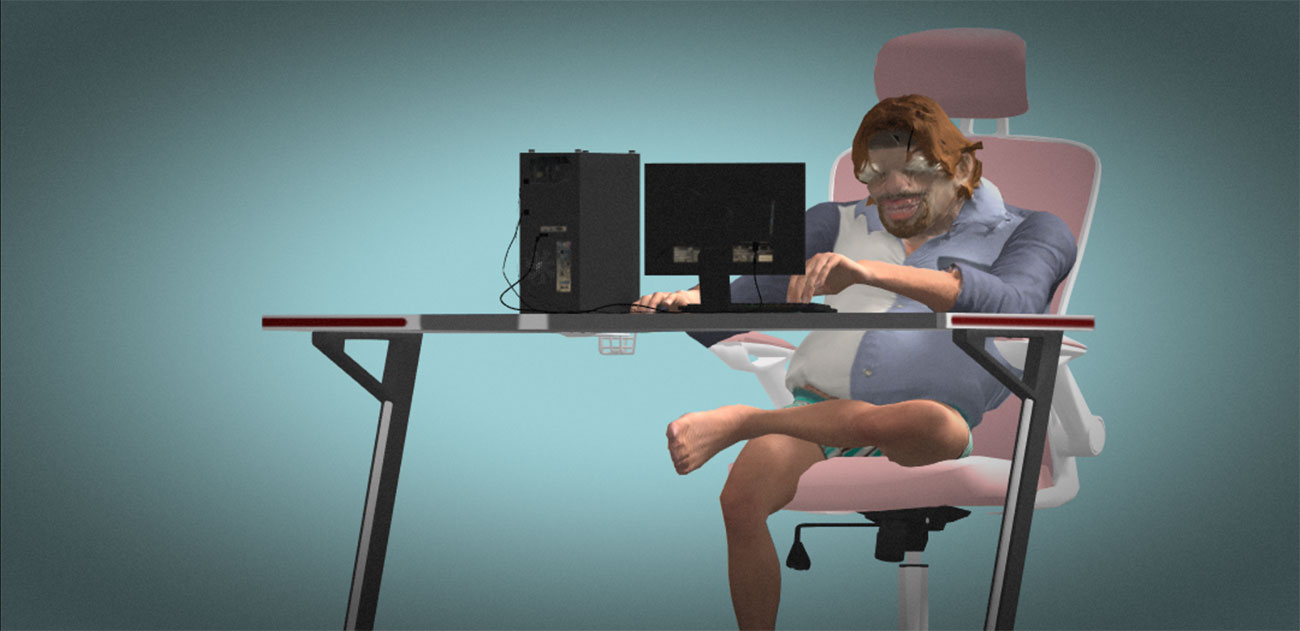
Constructed within the structure of a website, Desktop Studies consists of four interactive scenes (or levels) that explore the domain of Herne Hiili’s digital archive, rekindling moods and memories of the past. Each of these scenes is enriched with personal video snippets and musical fragments, providing a nostalgic and immersive journey through the contents of the artist digital history. This web-based project allows viewers to explore the interconnected layers of these experiences, evoking a sense of nostalgia and introspection while integrating multimedia elements that deepen the emotional and sensory connection with the material.
Desktop Studies, Interactive Website, Herne Hiili
😊 Click here for full screen view! 😊
Bio:
Herne Hiili is a 3D hobbyist & former professional gamer
Celebrating digital culture since 2o13, The Wrong organises art driven, multicultural, innovative and collaborative projects, online and offline, bringing together curators, artists and institutions.
The Wrong provides decentralised platforms open to participation, as a melting pot for the established, the emerging and the underrepresented, to explore creativity and digital culture in a positive and constructive way.
Showcasing a wide range of cultures, styles, and mediums to a global audience, The Wrong fosters an inclusive and diverse digital art scene, and encourages artistic growth and experimentation.
Desktop Studies is co-funded by the National Cultural Fund Administration and does not necessarily represent the position of the AFCN. AFCN is not responsible for the content of the project or how the results of the project may be used. These are entirely the responsibility of the beneficiary of the funding.
|go up|
